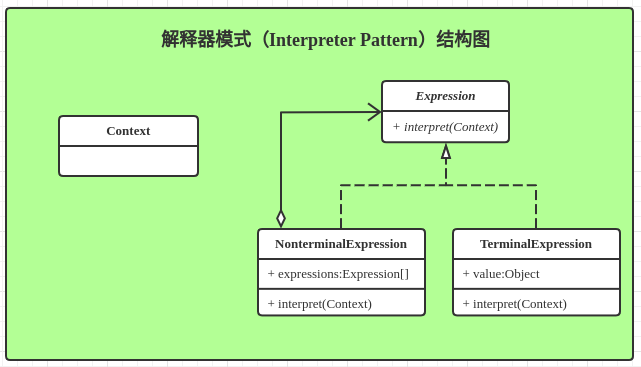设计模式之解释器模式
解释器模式
-
解释器模式结构图:

-
示例代码:
// 抽象表达式角色 public interface ArithmeticInterpreter { int interpret(); } // 终结表达式角色 public abstract class Interpreter implements ArithmeticInterpreter{ protected ArithmeticInterpreter left; protected ArithmeticInterpreter right; public Interpreter(ArithmeticInterpreter left, ArithmeticInterpreter right) { this.left = left; this.right = right; } } // 加法解释器 public class AddInterpreter extends Interpreter{ public AddInterpreter(ArithmeticInterpreter left, ArithmeticInterpreter right) { super(left, right); } @Override public int interpret() { return this.left.interpret() + this.right.interpret(); } } // 减法解释器 public class SubInterpreter extends Interpreter{ public SubInterpreter(ArithmeticInterpreter left, ArithmeticInterpreter right) { super(left, right); } @Override public int interpret() { return this.left.interpret() - this.right.interpret(); } } // 乘法解释器 public class MultiInterpreter extends Interpreter{ public MultiInterpreter(ArithmeticInterpreter left, ArithmeticInterpreter right) { super(left, right); } @Override public int interpret() { return this.left.interpret() * this.right.interpret(); } } // 除法解释器 public class DivInterpreter extends Interpreter{ public DivInterpreter(ArithmeticInterpreter left, ArithmeticInterpreter right) { super(left, right); } @Override public int interpret() { return this.left.interpret() / this.right.interpret(); } } // 数字表达式类 public class NumInterpreter implements ArithmeticInterpreter{ private int value; public NumInterpreter(int value) { this.value = value; } @Override public int interpret() { return value; } } // 计算器,没有考虑优先级,就是简单的从左到右的计算 public class GPCalculator { private Stack<ArithmeticInterpreter> stack = new Stack<>(); public GPCalculator(String expression){ this.parse(expression); } private void parse(String expression) { String[] elements = expression.split(" "); ArithmeticInterpreter left; ArithmeticInterpreter right; for (int i = 0; i < elements.length; i++) { String operator = elements[i]; if (OperatorUtil.ifOperator(operator)){ left = this.stack.pop(); right = new NumInterpreter(Integer.valueOf(elements[++i])); System.out.println("出栈" + left.interpret() + "和" + right.interpret()); this.stack.push(OperatorUtil.getInterpreter(left,right,operator)); System.out.println("应用运算符:" + operator); }else { NumInterpreter numInterpreter = new NumInterpreter(Integer.valueOf(elements[i])); this.stack.push(numInterpreter); System.out.println("入栈" + numInterpreter.interpret()); } } } public int calculate(){ return this.stack.pop().interpret(); } } // 工具类 public class OperatorUtil { public static boolean ifOperator(String operator) { return (operator.equals("+") || operator.equals("-") || operator.equals("*") || operator.equals("/")); } public static ArithmeticInterpreter getInterpreter(ArithmeticInterpreter left, ArithmeticInterpreter right, String operator) { if (operator.equals("+")){ return new AddInterpreter(left,right); }else if (operator.equals("-")){ return new SubInterpreter(left, right); }else if (operator.equals("*")){ return new MultiInterpreter(left, right); }else if (operator.equals("/")){ return new DivInterpreter(left, right); } return null; } } // 测试类 public class InterpreterTest { public static void main(String[] args) { System.out.println("result: " + new GPCalculator("10 + 30").calculate()); System.out.println("result: " + new GPCalculator("10 + 30 - 20").calculate()); System.out.println("result: " + new GPCalculator("100 * 2 + 30").calculate()); } } -
总结:
优点:解偶,增加了新的解释表达式的方式;
缺点:每个语法都要产生一个非终结符表达式,增加了系统的维护难度,解释器采用递归调用的方法,当完整表达式层级较深时,解释效率下降,且出错时调试困难.





【推荐】国内首个AI IDE,深度理解中文开发场景,立即下载体验Trae
【推荐】编程新体验,更懂你的AI,立即体验豆包MarsCode编程助手
【推荐】抖音旗下AI助手豆包,你的智能百科全书,全免费不限次数
【推荐】轻量又高性能的 SSH 工具 IShell:AI 加持,快人一步
· 从 HTTP 原因短语缺失研究 HTTP/2 和 HTTP/3 的设计差异
· AI与.NET技术实操系列:向量存储与相似性搜索在 .NET 中的实现
· 基于Microsoft.Extensions.AI核心库实现RAG应用
· Linux系列:如何用heaptrack跟踪.NET程序的非托管内存泄露
· 开发者必知的日志记录最佳实践
· winform 绘制太阳,地球,月球 运作规律
· TypeScript + Deepseek 打造卜卦网站:技术与玄学的结合
· AI 智能体引爆开源社区「GitHub 热点速览」
· 写一个简单的SQL生成工具
· Manus的开源复刻OpenManus初探